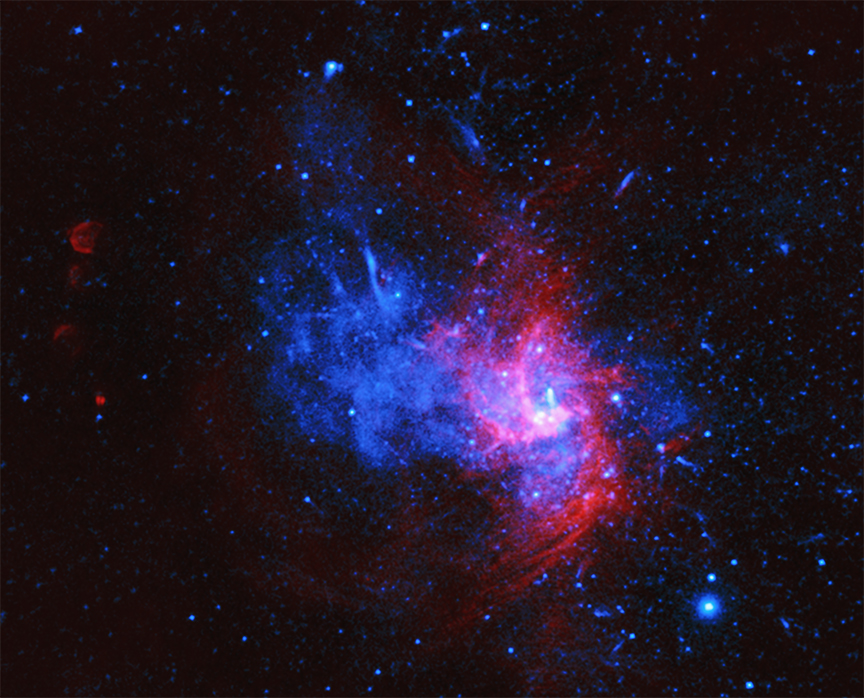Rare supernova relic found at the core of our Milky Way
NASA's Chandra X-ray Observatory has discovered the remains of a rare kind of stellar explosion near the center of the Milky Way.
Supernovas are stellar explosions that seed the galaxy with elements vital for life. Sagittarius A East (or Sgr A East) is a supernova remnant that lies near Sagittarius A* — the supermassive black hole in the center of the Milky Way. This supernova remnant is the first known example in our own Milky Way galaxy of an unusual type of white dwarf stellar explosion called a Type Iax supernova, according to a statement from the Chandra X-ray Observatory.
"While we've found Type Iax supernovae in other galaxies, we haven't identified evidence for one in the Milky Way until now," Ping Zhou, lead author of the study from Nanjing University in China, said in the statement. "This discovery is important for getting a handle of the myriad ways white dwarfs explode."
Related: Supernova photos: Great images of star explosions

There are different types of stellar explosions, ranging from those triggered by the collapse of massive stars, to those that are triggered by smaller white dwarf stars that have pulled too much material from a companion star or collided with another white dwarf.
White dwarf explosions — generally designated as Type Ia supernovas — are an important source of chromium, iron and nickel in the universe. However, using the Chandra observations, astronomers found Sgr A East produced different relative quantities of essential elements and created a less powerful explosion than a typical Type Ia supernova, suggesting it is instead a Type Iax supernova, according to the statement.
"This result shows us the diversity of types and causes of white dwarf explosions, and the different ways that they make these essential elements," Shing-Chi Leung, co-author of the study from the California Institute of Technology, said in the statement. "If we're right about the identity of this supernova's remains, it would be the nearest known example to Earth."
Get the Space.com Newsletter
Breaking space news, the latest updates on rocket launches, skywatching events and more!
To explain the differences observed between these two types of supernovas, astronomers have suggested thermonuclear reactions, which trigger stellar explosions, move more slowly through white dwarf stars that result in Type Iax supernovas compared to Type Ia supernovas. Slower thermonuclear reactions would result in weaker explosions and, in turn, the release of different quantities of elements produced in the explosion. Part of the white dwarf may also be left behind during Type Iax supernovas, according to the statement.
In addition to the X-ray data from Chandra, astronomers used computer models to simulate slow-moving nuclear reactions in white dwarf stars. The computer models supported the Chandra observations of Sgr A East, suggesting it is a Type Iax supernova remnant.
"This supernova remnant is in the background of many Chandra images of our galaxy's supermassive black hole taken over the last 20 years," Zhiyuan Li, co-author of the study from Nanjing University, said in the statement. "We finally may have worked out what this object is and how it came to be."
Their findings were published Feb. 10 in The Astrophysical Journal.
Follow Samantha Mathewson @Sam_Ashley13. Follow us on Twitter @Spacedotcom and on Facebook.
Join our Space Forums to keep talking space on the latest missions, night sky and more! And if you have a news tip, correction or comment, let us know at: community@space.com.

Samantha Mathewson joined Space.com as an intern in the summer of 2016. She received a B.A. in Journalism and Environmental Science at the University of New Haven, in Connecticut. Previously, her work has been published in Nature World News. When not writing or reading about science, Samantha enjoys traveling to new places and taking photos! You can follow her on Twitter @Sam_Ashley13.









